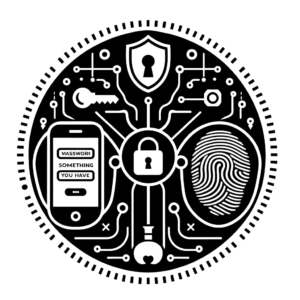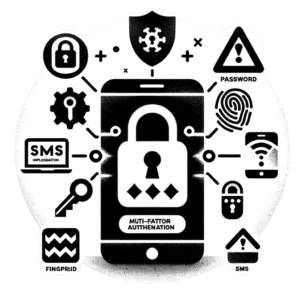Overview of Multi-Factor Authentication (MFA)

Multi-Factor Authentication (MFA or 2FA) is a really important security feature that helps keep your information safe from hackers. In today’s world, where online attacks are common, it’s crucial to have an extra level of security beyond just passwords. MFA makes users give two or more types of verification to access their accounts, like passwords, fingerprints, security codes, or one-time passwords (OTPs). This makes it a lot tougher for hackers to break into accounts.
Using 2FA can greatly lower the chances of someone unauthorized getting into your accounts and protect your personal information from being stolen. By having more than one security step in place, like using a password and a code sent to your phone, companies can make sure that their private information stays safe. This is especially important for people who work from home or have access to sensitive data, as it provides an additional level of protection from online dangers.
Overall, it matters because it enhances the overall security posture of organizations, mitigates the risk of cyberattacks, and protects user data. It is a fundamental cybersecurity measure that every individual and organization should implement to safeguard against evolving cyber threats in today’s digital landscape.
Why Talk About MFA in Today’s Context
In this day and age, online threats are always changing and getting more advanced. That’s why it’s important to talk about it to protect important information and stop unauthorized users. 2FA makes it harder for hackers to get into accounts by asking for more than one piece of information to prove a person’s identity.
As more people are working from home and using online services, it’s important to have strong cybersecurity measures like multi-factor authentication. Cybercriminals are always trying to find ways to break into systems, and weak passwords are a common target for attacks. By learning about its importance, both businesses and individuals can protect themselves from hackers and keep their information safe.
Rules like GDPR and HIPAA stress the need for strong security measures like 2fa to protect data privacy and follow regulations. Talking more about mfa and how it helps can make our digital world safer and protect against cyber attacks.
Basics of MFA: What It Is & How It Works
Multi-Factor Authentication is a special way to protect your personal details online. It double or even triple checks that it’s really you who’s trying to access your private accounts. It might ask you to provide extra information or go through additional steps to prove it’s you. Think of it as having an extra lock on your online life, which helps to keep your information even more secure as you use the internet.
So, how does it work? Well, when you try to log in, you need to do more than just enter a password. For example, you might also need to type in a code sent to your phone or use your fingerprint to unlock the account. By requiring multiple ways to confirm it’s really you, it makes it a lot tougher for someone to hack into your account without permission, even if one of the methods isn’t completely secure.
Implementing 2FA is crucial for businesses and individuals alike to prevent account takeover, data breaches, and identity theft. It adds a critical defense against phishing attacks, credential stuffing, and other common cyber threats. By making it more challenging for cybercriminals to gain access to accounts, it plays a vital role in safeguarding sensitive information and maintaining data integrity.
Types of MFA: Something You Know, Have, & Are
Multi-Factor Authentication is a very important security tool that goes beyond just using passwords. There are three main types of ways to prove you are who you say you are: something you know, something you have, and something you are.
The first category, something you know, usually involves things like passwords, PINs, or security questions. This is the basic way to confirm your identity.
The next category, something you have, includes physical items like a cell phone, smart card, or security token. This acts as a second way to confirm it’s really you trying to log in.
Finally, the something you are category includes unique things about you, like your fingerprint, face, or eyes. By using these different types of confirmation, it makes it much harder for someone who shouldn’t have access to get in.
The Role Of MFA In Today’s Digital Landscape
Multi-Factor Authentication is an important way to keep your information safe in our online world today. Cyber threats are getting more advanced, so just using a password is not enough to protect your data. It helps by asking for more than just a password before you can log into your accounts or systems.
Using more than one way to confirm you’re the true owner of your account, is vital because it makes it really tough for hackers to gain access without permission. In simple terms, it’s like adding extra locks to your vault – like fingerprints, codes sent via text message, or special devices – beyond just a normal password. This guards businesses and individuals against online attacks that aim to steal their personal details. Basically, MFA is like a security guard that helps keep your important information safe from hackers.
Additionally, it is important because it helps follow rules like GDPR and HIPAA, which require strong security measures to keep data safe and private. With cyber attacks becoming more sophisticated, using MFA is necessary to make sure your information is protected and reduce the chances of hackers getting into your accounts or stealing your identity.
Potential Pitfalls and Common Misconceptions
Multi-Factor Authentication is like an extra lock on your accounts and personal information to keep them safe. However, there are some things to keep in mind and misunderstandings to be aware of when using it to make sure it works effectively.
One common misconception is that 2FA is foolproof and can guarantee complete protection against cyber threats. While MFA significantly increases security, it is not immune to sophisticated hacking techniques. Users must still practice good cybersecurity habits to safeguard their information.
Another pitfall is the belief that MFA is a one-size-fits-all solution. Different platforms and applications may have varying requirements and implementations, leading to confusion and potential vulnerabilities if not set up correctly.
Moreover, relying solely on SMS-based MFA can pose a risk, as SMS messages can be intercepted or SIM swapped by attackers. Using more secure methods like authenticator apps or hardware tokens is advisable for enhanced protection.
Understanding these potential pitfalls and misconceptions is crucial for maximizing its effectiveness in bolstering cybersecurity defenses and safeguarding sensitive data.
Overcoming these Challenges & Adjusting MFA Strategy
Multi-Factor Authentication is really important for keeping your accounts safe, especially with all the cyber attacks happening now. You have to provide more than just a password to log in, which makes it much harder for hackers to get into your accounts without permission.
However, despite its effectiveness, it also presents challenges that organizations must overcome to ensure seamless implementation and user adoption. One common challenge is the inconvenience it may pose to users, leading to resistance and potential workarounds that can compromise security. Additionally, managing and maintaining multiple authentication factors can be complex and resource-intensive for IT teams.
To address these challenges, organizations need to continuously assess and adjust their MFA strategies. This includes evaluating user experience, implementing user-friendly authentication methods, and providing adequate support and training to users. It also involves staying informed about emerging threats and technologies to adapt MFA solutions accordingly.
Ultimately, overcoming these challenges and adjusting 2FA strategies is essential in ensuring robust security posture and safeguarding sensitive data from cyber threats.
Anticipating Changes & Improvements
Using 2FA is very important for keeping your private information safe and stopping people from getting into your accounts without permission. With new online dangers popping up all the time, it’s essential for businesses to keep up with the latest MFA tools to protect themselves and their customers.
MFA is important because it adds extra security measures on top of just using passwords. By having users verify their identity with things like fingerprints or security codes, it makes it much harder for unauthorized people to access accounts, even if passwords are stolen.
In the future, improvements in multi-factor authentication technology will make it easier and more user-friendly. This means using things like behavioral biometrics and adaptive authentication to ensure security while also making the process simpler and more convenient for everyone. These advancements will benefit both individuals and organizations.
It’s important for businesses to keep up with the latest trends and innovations in 2fa technology so they can make sure they’re using the best security measures to protect their important data.
Maintaining Flexibility in Your Approach
One key aspect of maintaining flexibility in your 2fa approach is adapting to new technologies and authentication methods. As hackers continue to develop sophisticated techniques to bypass security measures, it’s essential to stay one step ahead by incorporating the latest solutions such as biometric verification, hardware tokens, and push notifications.
It’s important to consistently review and update your policies and procedures for multi-factor authentication to keep up with security standards and user preferences. By customizing security measures based on the level of threat different users and systems face, you can ensure strong protection without making things too complicated.
